Create Solana Token The Smart & Scalable Way
- BLOG
- Uncategorized
- November 16, 2025
You’ve seen tokens explode overnight, some fade, some redefine entire markets. The difference? How they’re built. When you create Solana token, you’re not just minting another coin; you’re engineering speed, trust, and limitless potential into your idea.
Solana isn’t a playground, it’s the launchpad for creators who want their projects to move fast, scale wide, and stay affordable. It gives you the tools to turn innovation into impact without technical chaos or blockchain jargon holding you back.
Here, you’ll learn how to create a Solana token that captures attention and delivers real value. Not just another launch, something built to last and lead.
Contents
- 1 Why Create Solana Token
- 2 Understanding Key Concepts Before You Create a Solana Token
- 3 Tools and Resources for Solana Token Creation
- 4 The Step-by-Step Process to Create Solana Token
- 4.1 1. Set Up Your Wallet and Solana CLI
- 4.2 2. Create a New Token Mint
- 4.3 3. Create an Associated Token Account (ATA)
- 4.4 4. Mint Tokens to the Account
- 4.5 5. Upload Token Metadata
- 4.6 6. Test Transfers on Devnet or Testnet
- 4.7 7. Prepare for Mainnet Launch
- 4.8 8. Distribute and List the Token
- 4.9 9. Monitor and Maintain the Token
- 5 Build powerful Solana tokens with Webisoft effortlessly!
- 6 Technical Considerations When Creating a Solana Token
- 7 Common Mistakes to Avoid When Creating a Solana Token
- 7.1 Skipping Metadata or Using Poor-Quality Metadata
- 7.2 Ignoring Testnet or Devnet Testing
- 7.3 Keeping Mint Authority When You Should Revoke It
- 7.4 Not Planning Tokenomics or Distribution Clearly
- 7.5 Overlooking Compliance and Legal Checks
- 7.6 Poor Smart Contract or Key Management
- 7.7 Choosing the Wrong Token Standard or Wallet Support
- 8 How Webisoft Helps You Create Solana Token
- 9 Webisoft vs DIY Solana Token Creation
- 10 Build powerful Solana tokens with Webisoft effortlessly!
- 11 Conclusion
- 12 Frequently Asked Question
Why Create Solana Token
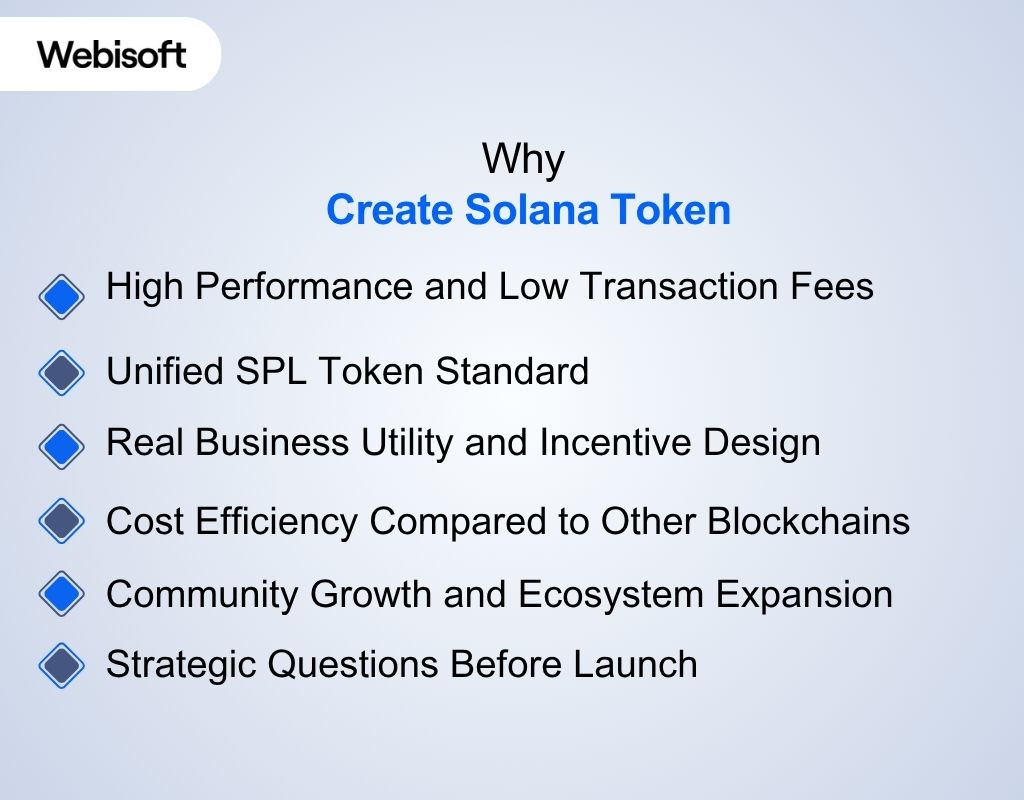 Every great blockchain project starts with a powerful token. On Solana, that token isn’t just code, it’s your project’s heartbeat.
Every great blockchain project starts with a powerful token. On Solana, that token isn’t just code, it’s your project’s heartbeat.
Fast, affordable, and scalable, Solana lets your idea grow without limits. Here’s why creating a Solana token could be the smartest move for your project’s future.
High Performance and Low Transaction Fees
Solana’s architecture combines Proof-of-History (PoH) and Proof-of-Stake (PoS) to process thousands of transactions per second with minimal costs.
This makes it ideal for businesses launching tokens that demand scalability, fast confirmations, and reliable on-chain interactions.
Unified SPL Token Standard
The SPL token standard powers both fungible and non-fungible tokens under one consistent framework. It ensures interoperability across wallets, DApps, and marketplaces, allowing smooth integration into Solana’s growing ecosystem.
Real Business Utility and Incentive Design
A custom token can represent utility, rewards, or governance rights within your ecosystem. Whether rewarding users, enabling DeFi transactions, or managing community voting, Solana tokens make your business model more interactive and decentralized.
Cost Efficiency Compared to Other Blockchains
Launching a token on Solana is cheaper and faster than many older chains like Ethereum, which often face network congestion and high gas fees. Solana’s lightweight design makes token deployment more accessible for startups and enterprises alike.
Community Growth and Ecosystem Expansion
Tokens act as a foundation for user engagement, helping projects build strong communities, reward participation, and align long-term incentives. This improves trust, loyalty, and adoption around your platform or product.
Strategic Questions Before Launch
Before creating a token, define its purpose, holders, and supply. Ask: What real value does this token deliver? A clear roadmap ensures your Solana token is not just functional, but impactful and sustainable.
Understanding Key Concepts Before You Create a Solana Token
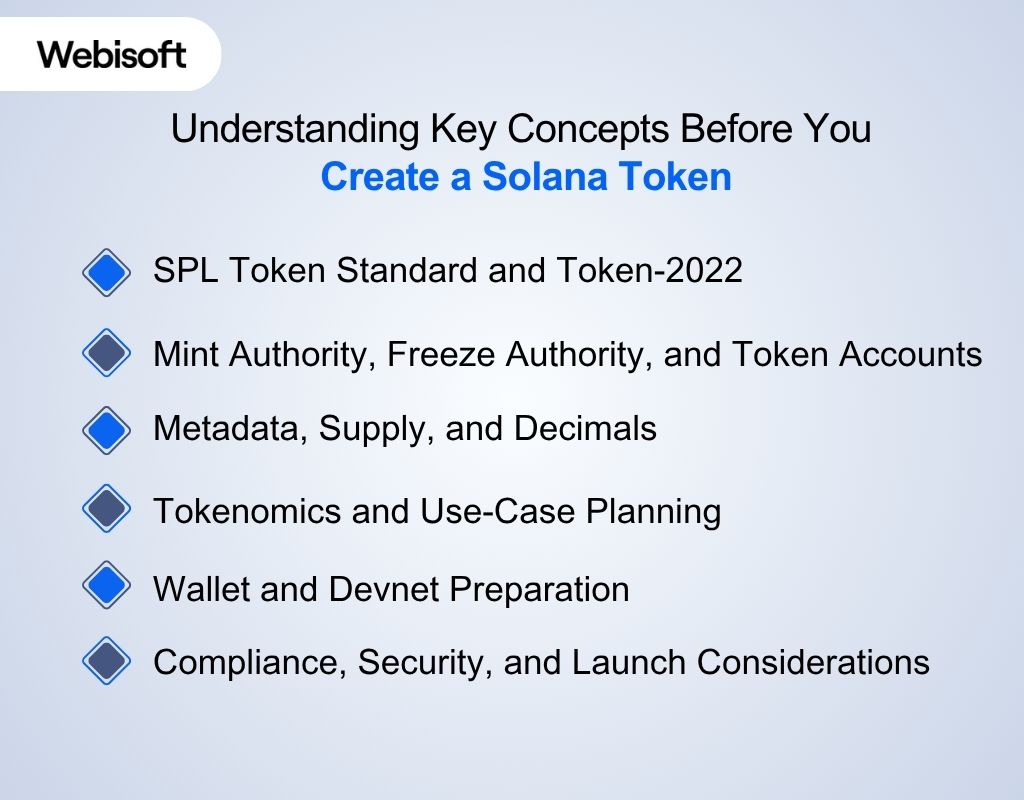 Once you understand why Solana tokens matter, the next step is mastering their foundation. Before creating your token, it’s essential to know the rules, tools, and structures that make Solana’s ecosystem secure and scalable.
Once you understand why Solana tokens matter, the next step is mastering their foundation. Before creating your token, it’s essential to know the rules, tools, and structures that make Solana’s ecosystem secure and scalable.
SPL Token Standard and Token-2022
The SPL Token Standard governs how tokens behave on Solana, covering minting, transfers, permissions, and metadata.
The Token-2022 extension adds flexibility with features like transfer fees, interest-bearing tokens, and advanced account controls. These standards ensure reliability and uniform functionality across Solana’s network.
Mint Authority, Freeze Authority, and Token Accounts
Every Solana token has a mint authority, the account that can issue new tokens and an optional freeze authority, which can pause transfers if needed.
Each wallet holds an Associated Token Account (ATA) to manage balances securely and efficiently within the Solana ecosystem.
Metadata, Supply, and Decimals
A well-structured token includes its total supply, symbol, and decimal precision for value representation. Metadata, stored off-chain through tools like Metaplex, defines your token’s name, image, and description.
See the Token Metadata Program-Metaplex Developers guide for full implementation.
Tokenomics and Use-Case Planning
Before launching, clearly outline your token’s purpose, whether for governance, rewards, or utility. Define supply limits, vesting schedules, and distribution models.
Thoughtful tokenomics ensures fairness, longevity, and community trust while avoiding inflation or supply mismanagement.
Wallet and Devnet Preparation
Testing on Solana Devnet prevents costly mainnet mistakes. Create a wallet such as Phantom, acquire test SOL, and connect through the Solana CLI or SDK. This step allows you to safely simulate minting, transfers, and token behavior before live deployment.
Compliance, Security, and Launch Considerations
Every token must meet legal and security standards. Review your jurisdiction’s regulations to avoid classification as a security.
Implement audits, multi-signature controls, and continuous monitoring to protect user funds and maintain project integrity post-launch.
Tools and Resources for Solana Token Creation
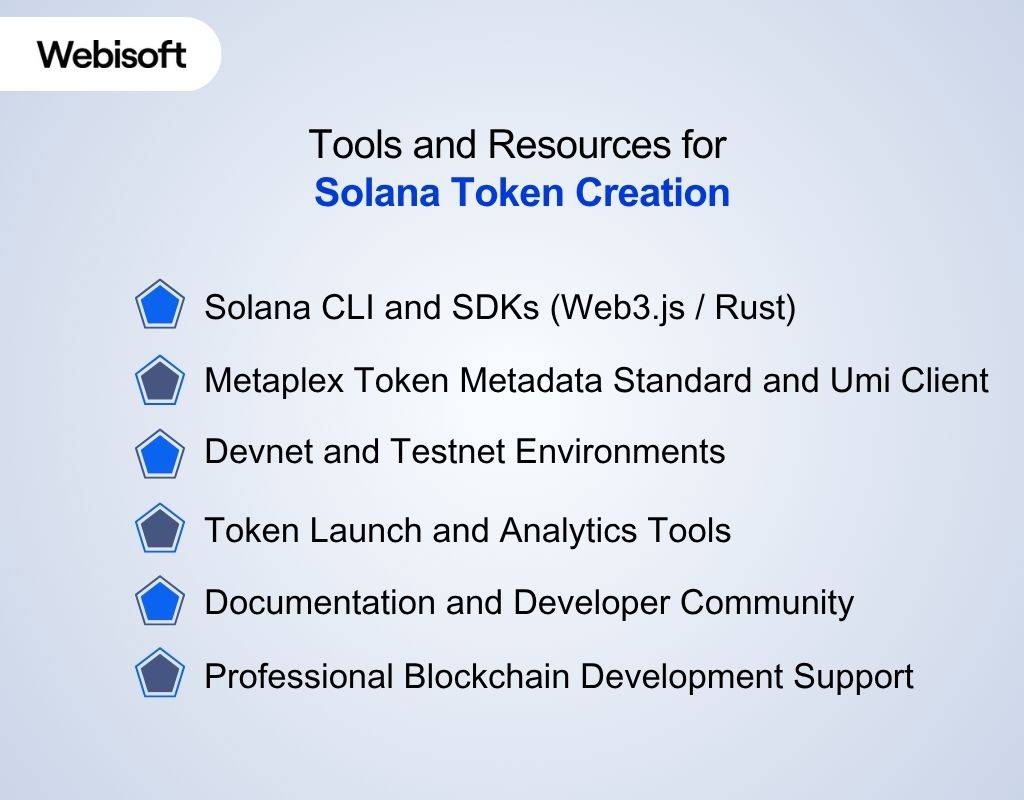 After learning the fundamentals of Solana tokens, it’s time to gather the right tools. The Solana ecosystem offers powerful frameworks and platforms that simplify token creation, testing, and management for developers and businesses alike.
After learning the fundamentals of Solana tokens, it’s time to gather the right tools. The Solana ecosystem offers powerful frameworks and platforms that simplify token creation, testing, and management for developers and businesses alike.
Solana CLI and SDKs (Web3.js / Rust)
The Solana Command-Line Interface (CLI) is essential for creating and managing token mints, accounts, and transfers.
Using Web3.js or Rust SDK, developers can automate operations, interact directly with Solana’s network, and deploy tokens quickly with precision and control.
Metaplex Token Metadata Standard and Umi Client
The Metaplex framework manages token metadata defining name, symbol, image, and external links. Through the Umi client, you can attach or update metadata files seamlessly.
This ensures your token displays correctly across wallets, DApps, and marketplaces, improving its visibility and credibility within the Solana ecosystem.
Devnet and Testnet Environments
Before launching on Mainnet, every project should test on Solana Devnet or Testnet. These environments allow safe experimentation using test SOL.
You can simulate minting, transferring, and freezing tokens without financial risk, ensuring a smooth and error-free mainnet deployment.
Token Launch and Analytics Tools
After creation, tools like Solscan, DexScreener, and Birdeye provide real-time analytics for tracking transactions, holder addresses, and liquidity.
These dashboards give clear insights into your token’s activity, helping you refine your strategy before full public release.
Documentation and Developer Community
The official Solana documentation offers complete technical references for SPL tokens, CLI commands, and wallet operations.
For troubleshooting or advanced guidance, join Solana’s developer communities on Discord, GitHub, or StackOverflow, where contributors share best practices and solutions.
Professional Blockchain Development Support
For teams without in-house blockchain expertise, Webisoft provides end-to-end token development services.
The experts handle everything from mint creation to audit, metadata configuration, and deployment with Custom Blockchain Development Services for businesses of all sizes.
So, turn your Solana token idea into reality by contacting Webisoft’s blockchain experts. It’s the best way to create Solana token that’s secure, fast, and reliable from concept to launch.
The Step-by-Step Process to Create Solana Token
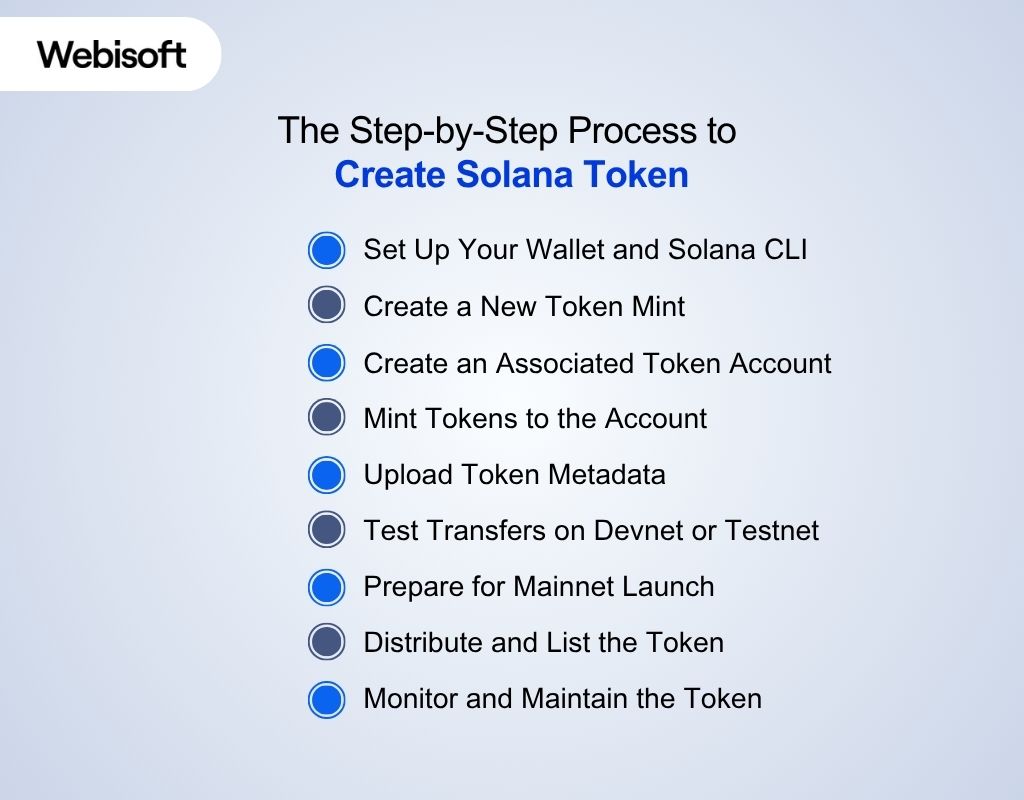 With the tools ready, the next phase is execution. To create Solana token online follows an organized process from environment setup to deployment. Each step ensures your token remains secure, verifiable, and compatible with Solana’s growing ecosystem.
With the tools ready, the next phase is execution. To create Solana token online follows an organized process from environment setup to deployment. Each step ensures your token remains secure, verifiable, and compatible with Solana’s growing ecosystem.
1. Set Up Your Wallet and Solana CLI
Begin by installing the Solana CLI, the command-line interface that connects you to the network. Generate a wallet key pair and switch to Devnet for testing: This creates a secure wallet with 2 test SOL.
Devnet allows you to simulate transactions without spending real tokens. Keep your wallet file safe, losing it means losing control of your token.
2. Create a New Token Mint
Your token begins with a mint address, the identifier that defines its supply and structure. Use the SPL CLI to create the mint and set your decimal count.
Decimals control divisibility, and choosing 9 decimals makes the token behave like SOL. Assign a mint authority during creation, which is the wallet allowed to issue tokens.
Keep this authority secure and confirm the mint address after the command.
3. Create an Associated Token Account (ATA)
Each wallet needs an Associated Token Account to hold your new token. Create it using the SPL CLI, which automatically generates the ATA for the wallet set in your Solana config.
This establishes the link between your wallet to the mint and produces the token account address you will use when minting.
4. Mint Tokens to the Account
Now, issue your token’s supply. Use your mint address and the token account you created earlier as the receiver. Use: If you want a fixed supply, revoke mint authority afterward.
This action is permanent and prevents any future minting. This locks your total supply and protects your token from unintended inflation.
5. Upload Token Metadata
Metadata defines your token’s name, symbol, description, and image. Upload your image to IPFS or Arweave, then create a JSON file following Metaplex’s metadata standard.
Use the Token Metadata program to upload the JSON and link it to your mint. Example JSON: This creates the on-chain metadata account that wallets and DApps use to display your token correctly.
6. Test Transfers on Devnet or Testnet
Transfer small amounts between wallets to ensure minting, decimals, and freeze authority behave correctly. Confirm transaction times and balances using Solana Explorer or Solscan. Fix issues before moving to Mainnet to avoid irreversible errors.
7. Prepare for Mainnet Launch
When testing is complete, switch networks: Recreate the mint, upload verified metadata, and ensure your wallet holds enough SOL to cover fees. Double-check authorities and token parameters before broadcasting.
8. Distribute and List the Token
Follow your tokenomics plan to distribute tokens to team wallets, investors, and community pools. Use time-locked or multi-signature accounts for transparency.
Begin DEX listings through Solana-integrated platforms like Raydium or Orca to create liquidity and visibility.
9. Monitor and Maintain the Token
Post-launch, track analytics using Solscan, DexScreener, or custom dashboards. Set up governance for upgrades or token burns.
Regularly audit your contracts, manage keys securely, and maintain transparency to build long-term community trust.
Build powerful Solana tokens with Webisoft effortlessly!
Get expert-led development, audits, and seamless mainnet launch support now.
Technical Considerations When Creating a Solana Token
 After completing the creation process, several technical aspects determine how your Solana token performs and scales.
After completing the creation process, several technical aspects determine how your Solana token performs and scales.
Addressing these considerations early ensures long-term security, efficiency, and compatibility within Solana’s rapidly changing blockchain ecosystem.
On-Chain vs Off-Chain Metadata
Storing metadata directly on-chain offers full decentralization but increases transaction and storage costs. Most projects store metadata off-chain using IPFS or Arweave, allowing easy updates to token details like name, image, and description while keeping blockchain data lightweight.
Token-2022 Extensions
The Token-2022 standard introduces advanced functionalities like transfer fees, interest-bearing tokens, and minting caps.
These features give projects more control and flexibility but require careful wallet and exchange compatibility checks to ensure smooth integration and user experience.
Supply Management: Mint, Burn, and Freeze
A well-designed token must define its supply behavior from the start. If the token’s supply is fixed, revoke the mint authority once creation is complete.
For tokens with dynamic supply, use the burn function to reduce circulation when needed. The freeze authority can be used to temporarily lock accounts during audits or incidents.
Smart Contract Security and Audit
Even though the SPL token program is battle-tested, integrating custom logic or metadata upload scripts introduces risk.
Always perform a professional audit before launch to identify vulnerabilities in your smart contracts or APIs. A small misconfiguration can expose wallets or allow unauthorized token manipulation.
Cost and Performance Optimization
While Solana offers low fees, inefficiencies can still add up. Compress metadata files, avoid unnecessary mint transactions, and optimize image storage to minimize costs.
Efficient code and streamlined processes ensure faster token interactions and better user experience.
Interoperability and Wallet Support
Your token should work seamlessly with Solana’s leading wallets such as Phantom, Solflare, and Backpack. Validate that your metadata and mint configurations display correctly in wallet interfaces and integrate smoothly with DEXs and DeFi platforms built on Solana.
Post-Launch Upgrades and Governance
As your ecosystem grows, you may introduce token governance, DAO participation, or feature upgrades. Plan these possibilities early by setting adaptable smart contract permissions.
Future-proofing your architecture now saves time, cost, and complications during expansion or community-driven updates.
Common Mistakes to Avoid When Creating a Solana Token
 Even with strong technical planning, small mistakes can derail your Solana token’s success. Avoiding these common pitfalls ensures your token remains secure, functional, and credible from creation to public launch within Solana’s fast-moving ecosystem.
Even with strong technical planning, small mistakes can derail your Solana token’s success. Avoiding these common pitfalls ensures your token remains secure, functional, and credible from creation to public launch within Solana’s fast-moving ecosystem.
Skipping Metadata or Using Poor-Quality Metadata
Incomplete or inconsistent metadata can make your token appear unverified or unprofessional. Always include an accurate name, symbol, image, and description.
Poor image quality, broken links, or missing symbols reduce credibility and may block your token from being listed on wallets or exchanges.
Ignoring Testnet or Devnet Testing
Deploying directly on Mainnet without testing is one of the biggest risks. Use Devnet to simulate minting, transfers, and authority functions.
This helps detect supply misconfigurations, permission errors, or metadata issues before any real value is at stake.
Keeping Mint Authority When You Should Revoke It
After completing your minting process, leaving the mint authority active allows unintended token inflation. Always revoke it once the supply is finalized: This action locks the total supply and ensures token stability.
Not Planning Tokenomics or Distribution Clearly
Undefined tokenomics can damage your project’s sustainability. Decide total supply, vesting timelines, and allocation ratios early. Avoid unfair or concentrated distributions that could harm community trust and token valuation after launch.
Overlooking Compliance and Legal Checks
Each jurisdiction treats tokens differently. A token considered a utility in one region may be classified as a security elsewhere.
Consult legal experts before launch to ensure full compliance with anti-money-laundering (AML) and know-your-customer (KYC) regulations.
Poor Smart Contract or Key Management
Neglecting security leads to exploits and permanent loss. Protect private keys with multi-signature wallets, revoke unnecessary permissions, and audit all custom code. Avoid single points of failure that could compromise token control or user funds.
Choosing the Wrong Token Standard or Wallet Support
Always confirm that your chosen standard (SPL or Token-2022) is supported by major wallets like Phantom and Solflare. Incompatible standards can prevent users from viewing, trading, or interacting with your token properly.
How Webisoft Helps You Create Solana Token
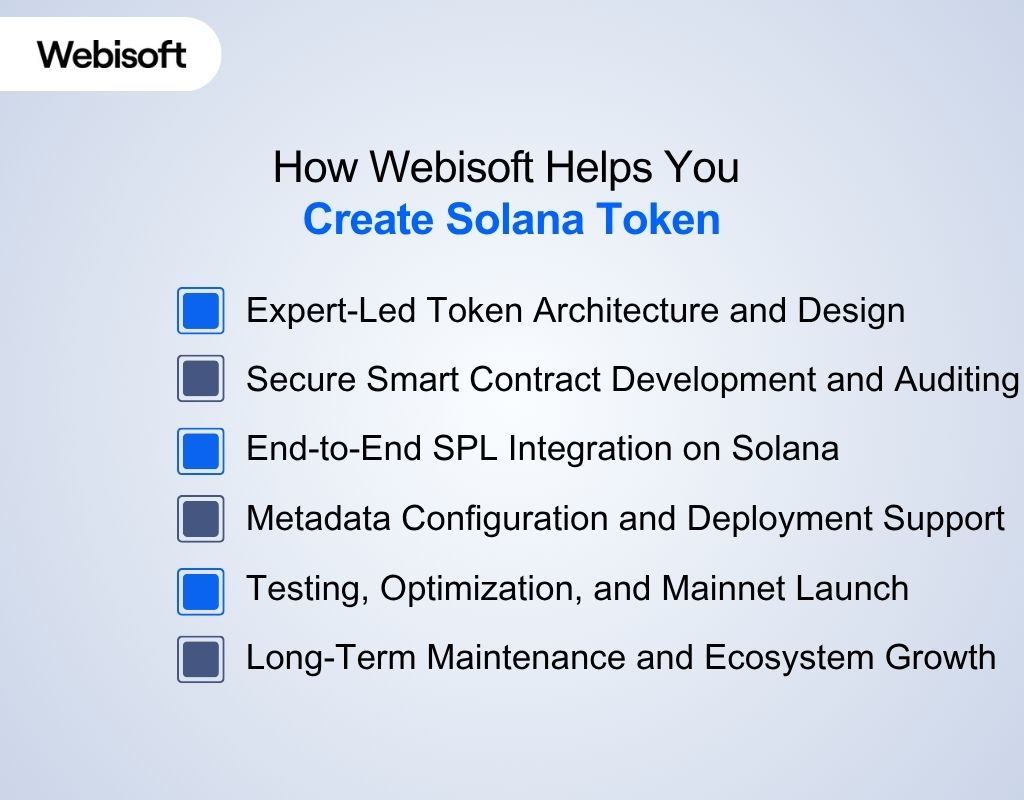 Turning a Solana token idea into a real, market-ready asset requires more than technical know-how; it demands expertise, precision, and strategy.
Turning a Solana token idea into a real, market-ready asset requires more than technical know-how; it demands expertise, precision, and strategy.
That’s where Webisoft comes in through its Blockchain Development Services. It’s your best Solana token creator, combining deep technical expertise with a hands-on approach that ensures every detail aligns with your goals.
Expert-Led Token Architecture and Design
Every successful token begins with solid architecture. Webisoft’s blockchain engineers help define your token’s purpose, supply model, authority setup, and governance logic.
Thus ensuring the foundation aligns perfectly with your business objectives and ecosystem goals.
Secure Smart Contract Development and Auditing
Webisoft develops and audits smart contracts following industry best practices. From minting functions to freeze authority and distribution controls, every contract is tested for vulnerabilities to guarantee a secure, transparent, and compliant launch.
End-to-End SPL Integration on Solana
The team handles all technical aspects of SPL standard integration, wallet compatibility, and Devnet testing. This ensures your token interacts flawlessly with Solana’s native protocols and is recognized by popular wallets and decentralized exchanges.
Metadata Configuration and Deployment Support
Webisoft manages complete metadata creation and upload, including name, symbol, description, and imagery. Metadata is stored securely on decentralized networks like IPFS or Arweave, ensuring your token displays correctly across all Solana-compatible platforms.
Testing, Optimization, and Mainnet Launch
Before going live, your token undergoes multiple rounds of testing on Solana Devnet to validate performance and scalability.
Once verified, Webisoft oversees the Mainnet deployment, guaranteeing a smooth transition from test environment to real-world ecosystem.
Long-Term Maintenance and Ecosystem Growth
After launch, Webisoft continues to provide technical maintenance, upgrades, and ecosystem expansion support.
Whether it’s implementing governance models, managing liquidity integrations, or planning future upgrades, the team ensures your token evolves sustainably within the Web3 landscape.
Webisoft vs DIY Solana Token Creation
When launching a Solana token, you can go the DIY route or choose the Webisoft route. Both can get you to mainnet, but the outcomes couldn’t be more different.
- Complexity
- DIY: Requires command-line expertise, SDK knowledge, and hands-on testing. Even small missteps can break deployment.
- Webisoft: Simplifies everything into a guided, agile process. Complex steps are handled by professionals with years of blockchain experience.
- Security
- DIY: No built-in audits or safety checks. A wrong configuration or unverified contract could expose vulnerabilities.
- Webisoft: Every token undergoes smart contract audits, authority validation, and wallet compatibility testing to guarantee security and reliability.
- Cost and Risk
- DIY: Cheaper upfront, but hidden costs arise from fixes, failed launches, and maintenance.
- Webisoft: Higher initial investment but lower long-term risk. You pay for stability, compliance, and scalability that lasts.
- Maintenance and Upgrades
- DIY: Post-launch support is on your shoulders, any bugs or governance changes require time and expertise.
- Webisoft: Provides continuous technical maintenance, performance optimization, and governance setup to evolve with your ecosystem.
- Outcome
- DIY: You might get a working token, but success depends entirely on your technical skills.
- Webisoft: You get a fully audited, business-ready token that’s secure, compliant, and built to grow with your project.
- Control
- DIY: You handle every step, installing the Solana CLI, managing commands, minting, and troubleshooting. Full control, but full responsibility for every mistake.
- Webisoft: Expert developers manage architecture, minting, metadata, and launch. You keep creative control while Webisoft ensures flawless technical execution.
Bottom Line: DIY creation might get you a token; Webisoft gets you a token that works, scales, and lasts.
For anyone looking to create your own Solana token for business, gaming, or DeFi, partnering with Webisoft ensures professional precision from day one.
Build powerful Solana tokens with Webisoft effortlessly!
Get expert-led development, audits, and seamless mainnet launch support now.
Conclusion
Creating a Solana token is more than pressing “deploy”, it’s the moment your idea becomes real. The decisions you make now how it’s built, tested, and launched, decide whether your token survives or fades into the noise.
That’s why Webisoft doesn’t just code; it collaborates. Every token they build carries purpose, precision, and long-term scalability.
So when your Solana token finally goes live, it doesn’t just exist, it leads. Whether you want to create Solana token free or build a fully customized one, Webisoft is where your blockchain journey begins.
Frequently Asked Question
Can I edit my Solana token after it’s created?
You can modify off-chain metadata such as name, image, or description stored on IPFS or Arweave. But core token parameters like total supply, decimals, and authorities are permanent once deployed on the Solana blockchain.
What is the minimum and maximum token supply I can set?
Solana has no fixed supply limits. You can mint as few or as many tokens as your project design demands. Still, maintain a balanced tokenomics model to support liquidity, utility, and long-term market stability.
Is it free to create a Solana token?
It is free to create a Solana token on Devnet because test SOL covers all actions. Mainnet deployment is not free since you need real SOL to pay network fees. Costs stay low because Solana processes transactions quickly with efficient validation.


